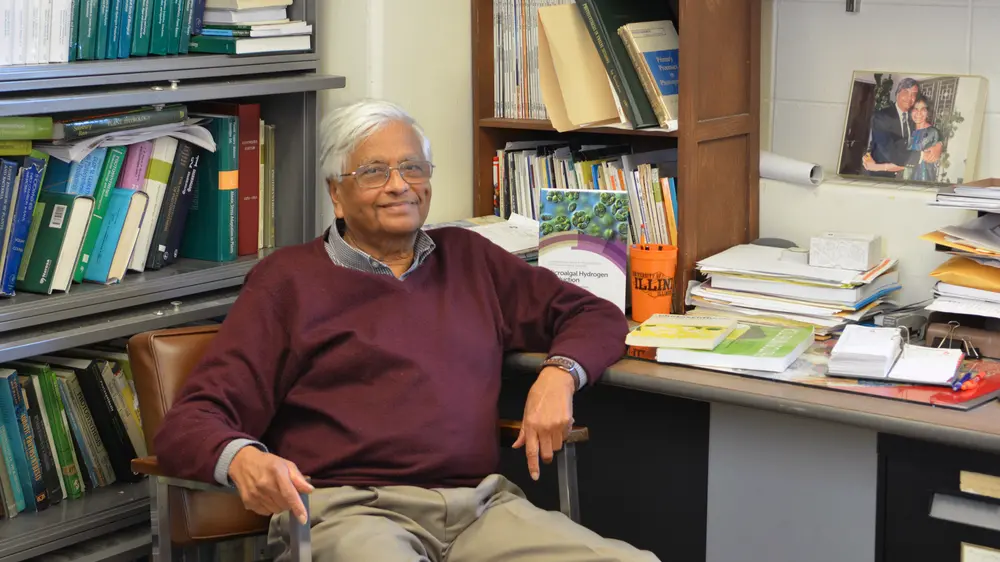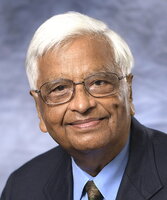
A career spanning six decades, over 400 papers, 25 graduate students, and numerous awards surely means a relaxing retirement? Not quite. Govindjee, at 86 years, is still dissecting the mechanisms of photosynthesis. He also collaborates with researchers across the globe to improve crops for food and energy production.
Govindjee’s interest in photosynthesis began during his undergraduate days at the University of Allahabad, India. “As the general secretary of the botanical society I had organized a mock symposium,” said Govindjee. “My classmates and I chose scientists to talk about and presented their work to the rest of the class. During that time, I was drawn to the research that was being done in photosynthesis.” Govindjee graduated in 1952 and decided to stay on to pursue his Masters in Botany, with a specialization in Plant Physiology.
“After my Master’s, I worked with Professor Shri Ranjan, who gave me the liberty to pursue whatever scientific questions I was interested in. The idea for my first paper was conceived when I was walking around the university and saw mottled plants with yellow spots on their leaves. I wanted to understand what caused this disorder, and I decided to look at the amino acid composition of these leaves,” explained Govindjee. “Ranjan’s lab did not have any of the required techniques or reagents. I learned how to do paper chromatography from the literature. We published these findings in Nature and the Proceedings of the National Institute of Science, India.”
Govindjee always knew that he wanted to pursue his PhD in the U.S. He was interested in the work that was being done by Melvin Calvin at the University of California at Berkeley and Robert Emerson at the University of Illinois at Urbana-Champaign. Calvin later won the Nobel Prize for investigating how plants and algae convert carbon dioxide to glucose during photosynthesis. Emerson had discovered an anomaly that far-red light was inefficient in photosynthesis. Govindjee wrote to both Calvin and Emerson and received admission at both universities. Additionally, he got a handwritten letter of invitation from Emerson offering him a fellowship, so he chose to come to UIUC.
Unfortunately, Emerson died in 1959, two and a half years after Govindjee joined his lab. The rest of his PhD was carried out under the guidance of Eugene Rabinowitch. After completing his degree in 1960, Govindjee joined the Biophysics Division of the Department of Physiology & Biophysics, and he has remained with the university ever since, serving Biophysics as well as Biochemisty and Plant Biology. “One of my lab’s main questions was directed at understanding how fast photosynthetic reactions occur. We were the first to measure the rates of the primary photochemical reactions at the picosecond level,” said Govindjee. His lab also dissected the unique role of bicarbonate during photosynthetic electron transport and pioneered the use of chlorophyll a fluorescence in monitoring photosynthetic reactions.
Although Govindjee no longer runs a lab, he collaborates with researchers from a range of countries, including India, China, Czech Republic, Hungary, Netherlands, and Sweden. “Scientists in India and China are aiming to improve different aspects of rice production. In India, they are trying to generate salt-tolerant varieties of rice, whereas in China they are investigating why certain varieties give a higher yield than others,” said Govindjee. “I am also interested in future collaborations on artificial photosynthesis, which can use different pigments to capture light energy and convert it to electricity.”
Govindjee also spends his time teaching photosynthesis to students in India and China in a unique way: he makes them enact the various processes that occur during photosynthesis. He is also a prolific writer, authoring books and articles on photosynthesis and its applications (his latest book, “Photosynthesis: Solar Energy for Life,” was just released), as well as tribute articles summarizing the research accomplishments of his colleagues. Furthermore, he is the founding editor of a highly influential series “Advances in Photosynthesis and Respiration,” now in its 45th volume.
“I continue to work on photosynthesis because the field excites me. As a scientist, you need to have an innate desire to understand how things work. You also need to recognize that science cannot be done in isolation. My work has led me to collaborate with different people around the world, without which many of the questions would have remained unanswered. In the end, you need to be excited about your work and find other scientists who share that enthusiasm.” He has been rightfully called Mister Photosynthesis.
